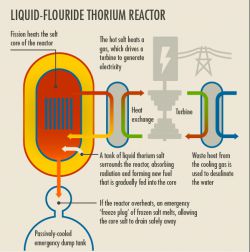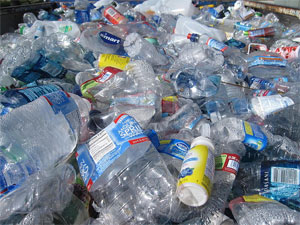As global demand for energy increases and access to fossil fuels decreases, we face a crisis. Nuclear power offers ecologically sound energy, but it is costly to produce and maintain. In the wake of the tragedy at the Japanese nuclear power plant Fukushima Daiichi, nuclear energy seems less safe in the eyes of the public, and, as a result, some nations are veering away from nuclear energy. Liquid fluoride thorium reactors are a next-generation nuclear energy option that offer all of the benefits of traditional uranium-based nuclear energy with several key advantages.
Nuclear Energy in the 21st Century
One of the greatest challenges we currently face is meeting the energy demand of our global community. We have relied on fossil fuels for energy in the past, but these fuels produce greenhouse gases that are destructive to the environment, and our supply of fossil fuels is rapidly depleting. Some ecologically conscientious energy sources have been developed: we now harvest the energies of the sun, wind, and ocean. But these solutions are not efficient enough to effectively meet our energy consumption, and cannot scale energy production with changing grid demands.
The grid demands less energy late at night when most people are asleep but uses more energy in the evening when people are home from work. Windmills, however, cannot produce energy without wind, and solar panels cannot produce energy during the night. They are, consequently, only circumstantial energy sources.
Currently, nuclear power is an energy solution that is carbon neutral and can produce energy to meet grid demand. However, it is expensive and difficult to deploy with absolute safety, as the world recently saw at the Fukushima Daiichi power plant in Japan following the 2011 earthquake and tsunami. Liquid Fluoride Thorium Reactors, however, offer safer nuclear technology, and promise cheap, efficient, carbon-neutral energy [1]. Thorium is a fairly sustainable source: the supply of thorium is estimated to be able to power the planet for another thousand years. The events at Fukushima illustrate the key safety advantages of a liquid fluoride thorium reactor, primarily being that it is not explosive nor can it melt down. This article looks at the technology behind LFTRs, the advantages of LFTRs over traditional nuclear reactors, and lastly what occurred at Fukushima Daiichi and why a LFTR could have prevented such a tragedy.
How a Liquid Fluoride Thorium Reactor Works
Thorium itself is not a nuclear fuel. The idea behind thorium as a fuel source originated from the fact that it can easily be turned into uranium, a fissile nuclear fuel. The process as shown in Fig. 1 starts with thorium232, a naturally occurring isotope that is so abundant that it is considered a “waste product” of mining operations. If thorium is bombarded with a single neutron, it will become uranium233 in roughly one month.
This uranium is fissile, and if it is again bombarded with a single neutron, it will split and release energy with two neutrons, which will continue on to split more atoms, further driving the fission reaction. This process is similar to current nuclear technology: both generate energy by splitting a uranium atom. The biggest difference between LFTRs and current nuclear reactors is that the fission reaction in LFTRs occurs in a molten salt solution instead of water, making the reaction more efficient while preventing a meltdown.
The reactor core of an LFTR, illustrated in Fig. 2, is comprised of a uranium salt core surrounded by a ‘fertile’ liquid thorium salt blanket. The reactor operates at a temperature of roughly 650˚C. The fuel core is composed of molten lithium fluoride, beryllium fluoride, and uranium tetrafluoride [2]. The uranium is the fissile material that produces heat in the nuclear reaction. The fertile blanket is composed of lithium fluoride, beryllium fluoride, and thorium tetrafluoride [2].
The fertile thorium blanket constantly produces new uranium atoms to fuel the reactor, by bombarding the thorium tetrafluoride with neutrons. Because the fission of the uranium in the fuel core produces two neutrons, one can be used to start turning a thorium atom in the fertile blanket into a new uranium atom, and one can be used to split another uranium atom in the reactor, generating more energy and two more neutrons. Thus, the reaction propagates itself without any external input after initial fission.
The reactor core generates usable energy by sending the hotter salt solutions that are near the reactor core to heat up helium gas in a heat exchanger. This heated helium gas then rotates a turbine that generates electricity, similar to current nuclear reactors. In the event of an emergency and power to an LFTR is cut, a plug of frozen salts, which was kept cool by a powered fan blowing cold gas on it, would be heated up by the molten salt in the reactor and would eventually melt. This would allow all of the material of the fuel core and fertile blanket to drain into a tank filled with materials that absorb excess neutrons, which would slow and ultimately end the fission reaction. The emergency safety features of current nuclear reactors require power input, which is often cut during the same emergencies that would activate the safety features in the first place.
Why a Liquid Fluoride Thorium Reactor is Better
First, thorium is extremely abundant in the crust of earth, unlike uranium. While uranium needs to be enriched before use, thorium is useful in its natural state, which makes thorium fuel cheaper to produce. Because the fission reactions in a LFTR are all based on liquid uranium, they are more efficient than equivalent reactions in a solid uranium reactor due to increased surface area for particle interaction. This means that LFTRs can produce much more energy per ton of fuel than current nuclear reactors [3]. Another big advantage of LFTRs over traditional uranium-based boiling water reactors is that LFTRs do not utilize water at any step, so they do not need to be built near a body of water. Because LFTRs do not utilize high pressure to maintain a stable reactor core, they do not need excessively thick walls around the core, so they can be smaller than current nuclear reactors [4].
Another key advantage of LFTRs is that they do not produce any dangerous nuclear materials. Weapons-grade nuclear materials such as plutonium239 or enriched uranium are not produced in the LFTR fission reaction, and it’s unfeasible to try to modify the reaction to produce them [5]. Radioactive byproducts of the fission of uranium bind with excess fluoride in the molten salt solution, which effectively neutralizes them. It’s also impossible for a meltdown to occur in an LFTR because the fission process is self-regulating. First, the molten salt solution can absorb substantially more heat than water, because it doesn’t become a gas until it reaches 1600˚C. As the fuel core heats up, the molten salt solution will expand, spreading out the uranium available for the fission reaction. If less uranium is being split, less heat will be produced and the molten salt solution will begin to contract. The reactor core effectively regulates its own pressure. In the unlikely event that temperatures increase beyond a controlled level, the whole core will be drained into a small containment vessel filled with material that can completely stop the fission reaction. Because a meltdown is impossible in an LFTR, there is no need for a large concrete containment structure around the reactor, which decreases the cost to build an LFTR based power plant.
Fukushima Daiichi: What went wrong?
The events at Fukushima Daiichi Reactor One put the reactor under the worst conditions imaginable. When the plant first sensed the earthquake, it injected zirconium alloy control rods into the reactor core to slow down the uranium fission process by absorbing excess neutrons. This will ultimately stop the fission reaction and subsequent heat production, but it takes a long time to completely halt the reaction. The 9.0-magnitude earthquake damaged the power lines feeding the reactor’s primary coolant system, which was taking heat away from the core [6]. As time went on, the primary coolant system completely failed. Normally, backup generators would take over and power the cooling process, but the tsunami following the earthquake destroyed all of the backup generators at Fukushima. Without the cooling system, heat began to build up in the reactor core. The hot uranium fuel rods began to melt the zirconium control rods. An oxidation reaction between the melting control rods and water in the reactor core produced hydrogen [6]. As any engineer will tell you, hydrogen is not the safest substance to keep in the extreme high pressure and temperature conditions of a uranium nuclear reactor core. The buildup of hydrogen combusted and created an explosion. This never would have happened with a LFTR; the LFTR cannot have a run-away heat reaction and operates under atmospheric pressure. An explosion in a LFTR is impossible.
As heat continued to accumulate in the reactor core, the mixture of molten Uranium fuel rods and Zirconium control rods began to melt through the walls of the reactor core. This process, diagramed by Fig. 3, is known as a meltdown. A meltdown is dangerous because the molten radioactive material can melt through the core and the concrete containment vessel, and if it reaches the outside it will release harmful radioactive particles into the environment. The engineers at Fukushima Daiichi were able to prevent a complete meltdown at Reactor One by ingeniously using fire trucks to pump cold seawater into the containment vessel to prevent heat build up.
A meltdown is impossible in a LFTR because when power is cut to a LFTR, the reactor core will shut itself off by melting the salt plug and draining into a control chamber. The control chamber can halt the fission reaction quickly in a LFTR because it takes a month to generate new uranium fuel from thorium atoms, and LFTRs cannot generate run-away heat production. Had the nuclear reactors at Fukushima been LFTRs, the whole crisis would have been avoided.
The Future of Nuclear Energy
Despite the tragedy at Fukushima, nuclear energy has a promising future; LFTRs have tremendous potential to be the next generation of energy. So why are they not being deployed? It would be very difficult to retrofit existing uranium-based nuclear power plants to become LFTR power plants. Furthermore, it would require a substantial capital investment to develop the techniques and materials needed to construct and operate a LFTR, and both nuclear energy companies and the government have already heavily invested their resources in current nuclear technologies and plants. The United States actually funded the development of a functional molten salt nuclear reactor in the 1970s, but the program was ultimately shut down after years of successful operation because power companies had already invested their money into uranium fast-breeder reactors, and because LFTR’s could not produce weapons-grade nuclear materials – a substantial drawback during the height of the Cold War. Currently, China is the only nation that is developing a modern LFTR. Maintaining our economic competition with China is a further reason for the US to start LFTR research now.
The good news is that we have already discovered the solution to the global energy crisis in LFTRs. Their thorium fuel source is abundant and cheap to produce. By design it’s impossible for them to explode or meltdown. They can run orders of magnitude more efficiently than existing nuclear plants. They could safely power the entire world while simultaneously preventing further damage to the environment caused by the greenhouse gases caused by current generation energy production. While pioneering this technology will require the ingenuity and passion of many engineers, the brighter future it promises is well worth the effort.






